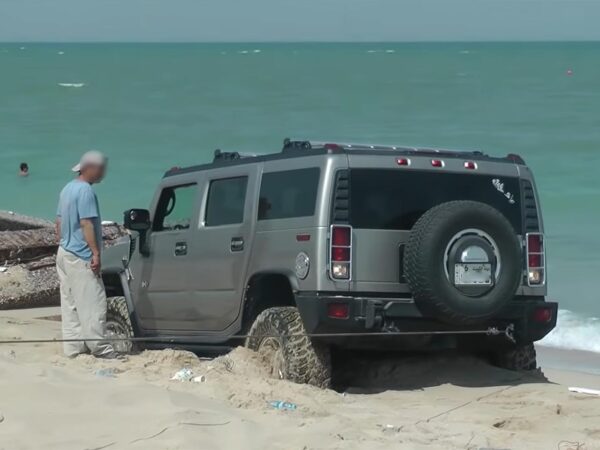A skilled driver might be able to take a car through tricky situations but sometimes, terrains win
To many, driving is mostly a want rather than a need. Oftentimes, proper petrolheads try to explore the potential of their car (or motorcycle) by taking the vehicle to some forms of extremity. This could be a full-throttle run, fast cornering or even tight parking manoeuvres (tighter; if done in reverse with music on). Be it any kind of testing on wheels, safety and responsibility should be prioritised over everything else.
There’s no harm in going relatively fast in the straights or curves as long as no other road user faces the slightest risk. The driving conditions (traction, visibility, path experience, etc.) just have to be favourable. However, one needs to understand the limits of a vehicle before venturing into unfamiliar roads, especially if the terrain is tricky.
Common sense plays a vital role over skill points here. For instance, an average subcompact crossover (or “compact SUV”) would be not able to go over rough terrain just because its TVC portrays so. A raised hatchback with bulkier fenders has its own limitations though this does not make it a bad purchase decision. Case in point: the rising demand for such vehicles in our country. That said, here are seven terrain situations you should not get yourself into as a responsible and sensible driver (unless you have a full-blown off-roader):
Beach (or saltwater in general)

Beaches are a fun place to be with one’s family and friends but it is best to leave the car in the parking lot. We have seen several viral videos of cars (from varied price segments) getting stuck in loose sand. It is particularly embarrassing if the vehicle is quite expensive and marketed as a capable off-roader. On the other hand, drive-in beaches get their title due to thicker sand layers similar to an unpaved yet level road. However, it is best not to get any car near the ocean since saltwater could prove harmful at internal locations even if the vehicle wears the highest grade of rust-protection.
Deserts & Sand Dunes

Even the most sought-after series-production off-roader may not prove enough to the uncertainty of the desert. Across a vast area of dry, loose and sloping sand formations, there could be pockets of extra-unsteady grounds. Desert driving without getting stuck, let alone dune-bashing, demands immense levels of skills and expertise. Interestingly, lower tyre pressure and ‘lack of’ ABS are crucial for ideal surface contact and braking performance. It would still be a big no-no for FWD vehicles (including crossovers commercialised as rugged SUVs).
Mud

Unless there is not much water involved, it is ‘relatively’ easier to get out of a muddy path — only with overwhelming patience and precise throttle inputs. The worst thing to do in such a situation is desperately trying to get out by apply full throttle. This would only bury the car deeper. A recommended step is to stop the vehicle the moment you sense traction lose, gradually try going in reverse, and if successful, steering away from the previous track.
Flood & Deep Water Bodies

In the general scenario, fire has more destructive power than water. But in internal combustion engines, the case is its exact opposite. Excess water content can clog the fuel lines and damage sensors, injectors and other sophisticated components. This usually happens while driving through flooded areas or across deep rivers. It could also cause ‘hydrolock’ — engine failure due to excess liquid content inside the cylinder (affecting compression and thereby leading to mechanical stress). Ironically, water gives more chances for an engine explosion than fire. Lifted vehicles with external snorkels rarely fall victim to this.
Rocks

If we take a proper 4×4 SUV, it could have all the basic mechanicals to climb steep inclines and traverse rocky formations. However, in most cases, the manufacturer would not recommend doing it due to the inconsistency involved with challenging terrains in different parts of the world. Rocky paths often hide sharp edges amidst the overall visual confusion. Even the slightest hit could lead to serious damage to a car’s underbody. Purpose-built off-roaders are equipped with bash plates and other protective panels to avoid such a situation. Furthermore, there is a reason why a good majority of crossovers are dubbed ‘soft off-roaders’.
Snow

This does not apply to the wider proportion of Indian drivers. Yet chances of getting stuck in snowy driving conditions are pretty high in an off-season North India trip by road. For starters, the roads would be extremely slippery due to slim ice formations if not for thick layers of snow. If one needs to tackle snowy terrains in a regular non-4×4 vehicle, studded tyres or chained wheels are must-haves. Extra company is also highly recommended.
Road Separators

In daily driving conditions, road separators (medians, pavements, dividers, etc.) are a common sight. Ideally, no driver would even think of going over them but certain situations (for instance, medical emergency) might demand it. We often see ambulances, fire engines or other emergency services driving like this. However, a passenger vehicle with substantially lower ground clearance and ruggedness may not be a wise choice for the job. Even a small nail beside the tarmac can put the passengers or other road users at risk.

